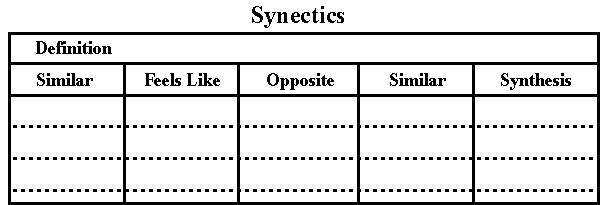
Synectics
Graphic
Organizers
"Creativity -- nothing more than
following a systematic process,
allowing random connections to take place, and
using your intuition to develop unique solutions.
Oh, by the way,
it's much easier and much more fun
when you work with others throughout the process." - Doug

Background Information: Synectics (Gordon,
1961) provides an approach to creative thinking that depends on
looking at, what appears on the surface as, unrelated phenomenon and
drawing relevant connections. Its main tools, analogies or metaphors.
The approach, often used in groupwork, can help students develop
creative responses to problem solving, to retain new information, to
assist in generating writing, and to explore social and disciplinary
problems. It helps users break existing minds sets and internalize
abstract concepts. Synectics works well with all ages as well as
those who withdraw from traditional methods (Couch, 1993).
Top |
Process: Teacher-facilitators use synectics in the classroom
by leading students through a process which results in a three
dimensional view of the "problem" in order to create solutions.
Although this process appears a bit cumbersome, the resultant scope
and depth of your options will justify the time spent.
Remember, tools, when used for the right types of jobs hold great
value; synectics does not work for every job.
- Define the word(s): Use a dictionary or
other standard source to define each word, concept, or theme. I
prefer an unabridged dictionary for more detailed
definitions.
See Try
it, it works for a word list and
suggestions on "being part of it" or on tolerance. This process works with a multitude of content
areas.
To ensure a fresh view generate each of the
following lists separately, put the current list away, and start
the next list after a break of at least five to ten minutes. If
time permits longer breaks yield more beneficial results.
When using synectics to
define a person, appropriate for self evaluation, focus your
questions on the areas of physical attributes, skills,
interests, personality traits, attitudes, and emotional
states.
- Create direct analogies: What words have
the same or similar meaning? (use a Thesaurus or book of
synonyms)
- Describe personal analogies: What would it
feel like to have the characteristics or traits of…?
(describe emotions and physical attributes)
- Identify compressed conflicts: What words
have the opposite meaning or characteristics? (use a book of
antonyms)
- Create a new direct analogy: What words
have the same or similar meaning?
Yes, this repeats the prompt from the second step. The difference,
after going through the first three lists you will have gone
deeper into the subject and this list will reflect that depth.
- Synthesis: Look at all four lists and
find key words or phrases, expand on those to generate more.
Finally, focus on a theme that may incorporate several elements
based on the final list.
Try it, it
works | Top
I have used this process many times and I'm always
amazed at the connections.
I've created word lists for two different topics,
"being part of it" and tolerance. I use the appropriate list of words to elicit multimedia
pieces. I allow students to work independently or in a group with no
more than three, unless you feel the people can work together...? In a group of three, I have the expectation of
"multi"media, e.g. music, visual art, writing, theatre, etc. But, then again, maybe you have a swing band, dance or circus troupe, or a large choir. Limits are good, but don't let them stifle your imagination.
Feel free to give this a try, but be warned,
students will whine and complain at the beginning. Keep encouraging
them to use the process. It works. With younger students try going
through the process with only one word, concept, or theme, and of
course you may want to create your own word list.
Put each word on a small piece of paper and then
let the students randomly select one to three words. I put the whole
list into a three column Word document, leaving about a half inch in
between, then cut them out and put them in a baggy. Have
fun.
"My fellow Americans, ask not what your country can do for you, ask what you can do for your country." - J F Kennedy
"Be part of it" word list | Top
abstract
accepted
accurate
adhere
alienated
align
ally
allotment
alone
application
apply
Assimilate
band
bi-partisan
bond
break
build
caravan
cell
cohort
committed
committee
community
compartmentalize
compatriate
congeal
connected
conspicuous
construct
create
crowd
decompose
deconstruct
denied
destroy
disintegrate
dismantle
disrupt
division
duet
elusive
empathy
empower
empty
encourage
enemy
energy
|
ensemble
exclude
exemplify
exploit
family
farmyard
flock
flotilla
fractured
fragment
friend
frustrated
full
fun
gaggle
gang
group
heal
heard
heap
heterogeneous
hire
homogeneous
I
ignore
illustrate
immersed
include
individual
inquisitive
inspired
integrate
integrity
interrupt
invigorate
isolate
lemming
lonely
mend
mob
movement
nest
nonproductive
nothing
null
ostentatious
ostracized
|
part
partial
Partisan
play
portion
posse
pride
productive
pull
push
random
rejuvenate
remove
removed
repress
resist
revisit
revitalize
sabotage
segment
segregate
separate
share
solo
spectacle
splinter
spontaneous
squad
subjugate
support
swarm
synthesis
synthesize
tangential
team
tear
them
together
trio
uncommitted
united
us
void
wagon train
we
whole
you
|
Tolerance word list | Top
|
adultery
advertising
affirmative
action
anarchy
anti-Semitism
appropriateness
bias
bigotry
blasphemy
books
cable television
CD-ROM
chaos
chauvinism
computer hackers
computer viruses
conformity
content-neutral
crime
democracy civilization
discrimination
disruption
domination
e-mail
education
espionage
exploitation
exploration
expression
fidelity
films
flaming (e-mail)
freedom
gender equity
genocide
|
glass ceiling
Greenpeace
homophobia
homosexuality
imagination
indecent
inflammatory
institutional racism
interference
Internet
intimidation
intolerance
invasion
justice
libelous
liberty
magazines
mail fraud
mixed relationships
monogamy
morality
movies
murder
NatRifleAssoc (NRA)
naturalism
nonpartisanship
nudity
objectionable
obscenity
offensive
partisanship
peace
personal diaries
politically correct
pornography
|
prejudice
privacy
prohibited
propaganda
prostitution
protection
prudence
racism
radio
reasonable
religion
religious right
repression
responsible standards
restraint
restriction
righteousness
sabotage
security
sex
sexual harassment
slander
society
Spanish inquisition
submission
suppression
television
theft
threat
tolerance
unclean
Victorianism
video
violation
violence
|
For more information | Top
Simon Wiesenthal Center Multimedia Learning
Center Online - http://motlc.wiesenthal.com/
- Provides a comprehensive resource on the Holocaust and WWII,
virtual exhibits, a teacher's resource center, special collections
from the Institute of Documentation in Israel, and more.
Southern Poverty Law Center (SPLC) - Teaching
Tolerance - http://www.splcenter.org/teachingtolerance/tt-index.html
- A national education project dedicated to helping teachers foster
equity, respect, and understanding in the classroom and
beyond.
Trigger Questions - http://members.ozemail.com.au/%7Ecaveman/Creative/Techniques/syn_quest.htm
- Take creative action by using the Trigger Questions to transform
your ideas and information into something new. These questions are
tools for transformational thinking and may lead you to some great
discoveries.
Other graphic organizers available throughout this
site.
Site
Map - A list of all the pages with
annotations, yes, all of the pages on this site.
Teachers
- Make sure you check out the Assignments
section which provides exercises, projects, support resources, and
rubrics.
Quotes
- New links and lots of new quotes about life, art, and
philosophy.
Historical
and Cultural Context - provides an
overview of art movements and the context in which they developed. We
have not covered every movement or period, rather selected snippets
to help provide students with an opportunity to explore the elements
that have influenced other artists in their quest for expressing
personal voice. As with all of our work, this site remains a work in
progress.

Wow, validation.
Check out edHelper.com
to find more educational resources, lesson plans, news updates, and
more.
For more graphic organizers see:
Graphic Organizer Index - http://www.graphic.org/goindex.html
- provides a matrix of organizers with practical applications for
each category.
Site
Map | Graphic
Organizers | Quotes
| WordList
| Glossary
| Rules
of Thumb | On-Line
Resources | WriteDesign
| Co-Teachers - Doug
and Melissa
| Gallery
| Top
E-Mail Doug at mrdoug@aznet.net
or Melissa at mmckinstry@sdja.com
|

|
Melissa and I would like to
thank znet
for
making a commitment to
education and WriteDesign.
|
References:
Kipperman, D., & Linder, D. (1995).
CerebralFlatulence. In EdTec 670 Cardboard Cognition.
Available: http://edweb.sdsu.edu/courses/edtec670/Cardboard/card/c/CerebralFlat.html
Couch, Richard (1993). Synectics and Imagery:
Developing Creative Thinking Through Images. In: Art, Science
& Visual Literacy: Selected Readings from the Annual Conference
of the International Visual Literacy Association (24th, Pittsburgh,
PA. September 30 - October 4, 1992). (ERIC Document Reproduction
Service No. ED 363 330)
Gordon, W.J.J. (1961). Synectics. New York:
Harper & Row.


